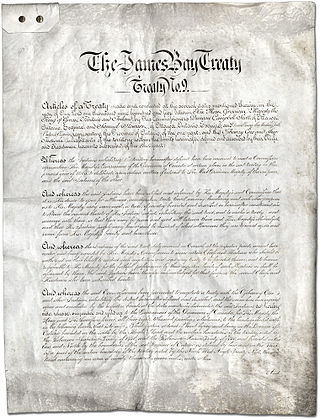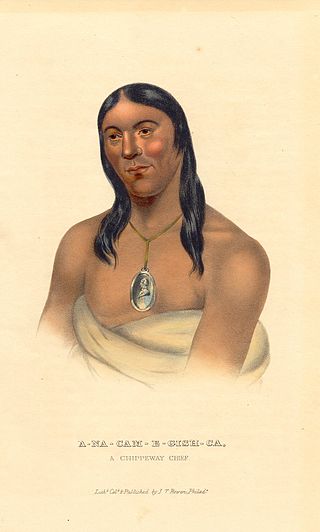
The Ojibwe, Ojibwa, Chippewa, or Saulteaux are an Anishinaabe people in what is currently southern Canada, the northern Midwestern United States, and Northern Plains. They are Indigenous peoples of the Subarctic and Northeastern Woodlands.

The Saulteaux, otherwise known as the Plains Ojibwe, are a First Nations band government in Ontario, Manitoba, Saskatchewan, Alberta and British Columbia, Canada. They are a branch of the Ojibwe who pushed west. They formed a mixed culture of woodlands and plains Indigenous customs and traditions.

Lake of the Woods is a lake occupying parts of the Canadian provinces of Ontario and Manitoba and the U.S. state of Minnesota. Lake of the Woods is over 70 miles (110 km) long and wide, containing more than 14,552 islands and 65,000 miles (105,000 km) of shoreline. It is fed by the Rainy River, Shoal Lake, Kakagi Lake and other smaller rivers. The lake drains into the Winnipeg River and then into Lake Winnipeg. Ultimately, its outflow goes north through the Nelson River to Hudson Bay.
First Nations in Ontario constitute many nations. Common First Nations ethnicities in the province include the Anishinaabe, Haudenosaunee, and the Cree. In southern portions of this province, there are reserves of the Mohawk, Cayuga, Onondaga, Oneida, Seneca and Tuscarora.
Asubpeeschoseewagong First Nation is an Ojibwe First Nations band government who inhabit northern Kenora in Ontario, Canada. Their landbase is the 4,145 ha English River 21 Indian Reserve. It has a registered population of 1,595 as of October 2019, of which the on-reserve population was 971. As of October 2023, the community had a registered population of 1,608. They are a signatory to Treaty 3.

Treaty No. 9 is a numbered treaty first signed in 1905-1906 between Anishinaabe and Omushkegowuk Cree communities and the Canadian Crown, which includes both the government of Canada and the government of the province of Ontario. It is commonly known as the "James Bay Treaty," since the eastern edge of the treaty territory is the shore of James Bay in Northern Ontario.
Chapleau Ojibway First Nation is an Ojibwa First Nation located near Chapleau Township, Sudbury District, Ontario, Canada. The First Nation have reserved for themselves the 67 ha Chapleau 61A Indian Reserve, 64.7 ha Chapleau 74 Indian Reserve and the 799.3 ha Chapleau 74A Indian Reserve. In September, 2007, their total registered population 39, of which their on-reserve population was 30.
Nigigoonsiminikaaning First Nation, formerly known as the Nicickousemenecaning First Nation and as the Red Gut First Nation, is a Saulteaux First Nation band government who inhabit the banks of Rainy Lake of the Rainy River District in Northwestern Ontario, Canada. As of January, 2008, the First Nation had a population of 290 registered people. As of 2017, it has approximately 130 on-reserve members.
Lac La Croix First Nation is a Saulteaux First Nation band government who reside in the Rainy River District of northwestern Ontario, Canada, along the Ontario-Minnesota border. It is approximately 200 km northwest of Thunder Bay, Ontario. As of January 2008, the First Nation had a registered population of 398 people, of which their on-Reserve population was 273.
Grand Council of Treaty 3 (GCT3) is a political organization representing 24 First Nation communities across Treaty 3 areas of northern Ontario and southeastern Manitoba, Canada, and four additional First Nations, specifically in regard to their Treaty rights.
The Anishinaabe Nation in Treaty No. 3 is a sovereign Anishinaabe Nation in Canada. It has existed as a self-governing people with its own laws and government institutions since time immemorial, before the arrival of European settlers. "America, separated from Europe by a wide ocean, was inhabited by ... separate nations, independent of each other and of the rest of the world, having institutions of their own, and governing themselves by their own laws." "The territory included in Treaty #3 in 1873 was governed by a Grand Council of Anishinaabe Chiefs. ... This civil leadership was responding to other political ranks and ultimately to the constituent families." The Nation is, by constitutional definition, the Anishinaabe people that entered into Treaty 3 with the Crown in 1873.
The Naicatchewenin First Nation, also known as the Anishinaabeg of Nagaajiwanaang and formerly known as Northwest Bay First Nation, inhabited a region in Ontario that was cited in the Northwest Angle Treaty of 1873, also known as Treaty 3. Nagaajiwanaang is located approximately 60 kilometres (37 mi) northwest of Fort Frances, with the community of Devlin 50 kilometres (31 mi) to the south on Highway 11. The city of Thunder Bay lies 420 kilometres (260 mi) to the east and Winnipeg is 450 kilometres (280 mi) to the northwest.

Rainy Lake and River Bands of Saulteaux are Saulteaux (Ojibwe) group located in Northwestern Ontario and northern Minnesota, along and about the Rainy Lake and the Rainy River, known in Ojibwe as Gojijiing.

Seine River First Nation, previously known as the Rivière la Seine Band, is an Ojibwe First Nation reserve located roughly 300 kilometres (190 mi) west of Thunder Bay, Ontario. As of November 2011, the First Nation had a total registered population of 725, of which 327 lived on their own reserve.
Big Grassy First Nation is an Ojibwe or Ontario Saulteaux First Nation band government located in Rainy River District, Ontario near Morson, Ontario.
Ojibways of Onigaming First Nation is an Ojibwe or Ontario Saulteaux First Nation located in Kenora District, Ontario near Nestor Falls, Ontario. Together with the Big Grassy First Nation, Ojibways of Onigaming First Nation is a successor apparent to the former Assabaska Band of Saulteaux. Total registered population in February, 2012, was 737, of which the on-reserve population was 445. The First Nation is a member of the Anishinabeg of Kabapikotawangag Resource Council, a regional tribal council that is a member of the Grand Council of Treaty 3.

Seven Generations Education Institute is an Aboriginal-owned and controlled post-secondary institution, co-founded by the ten bands in the Rainy Lake Tribal area in 1985. The ten bands are: Big Grassy, Big Island, Couchiching, Lac La Croix, Naicatchewenin, Nigigoonsiminikaaning, Ojibways of Onigaming, Rainy River, Seine River and Mitaanjigamiing. Each of the bands appointed one member to the board of directors of Seven Generations Education Institute, which functions with the leadership of the Executive Director.
Anishinabe of Wauzhushk Onigum is an Anishinaabe First Nation in northwestern Ontario. Its reserves include Kenora 38B and the shared reserve of Agency 30. It is a part of the Anishinabeg of Kabapikotawangag Resource Council, a party to the Grand Council of Treaty 3. Wauzhushk Onigum is govern by 1 Chief and 3 Council members. Current Chief is Chris Skead and council members are Dave Skead, Ed Skeid and Donald Biggeorge. Chief and council are elected by members of Wauzhushk Onigum.
Agency 30 is a First Nations reserve on the Aulneau Peninsula of Lake of the Woods in northwestern Ontario. It is shared by 13 First Nations:

Grassy Narrows First Nation v. Ontario [2014] SCR 48, [2014] 2 S.C.R. 447 was a July 11, 2014 decision by the Supreme Court of Canada in case number 35379 in which an appeal made by the Government of Ontario was allowed. The result of Grassy Narrows v. Ontario, while legal, was deemed unfair by some to Grassy Narrows First Nation, as "it has put them in a situation of having negotiated with a party who then ceased to be a party when it came to honouring the agreement."








